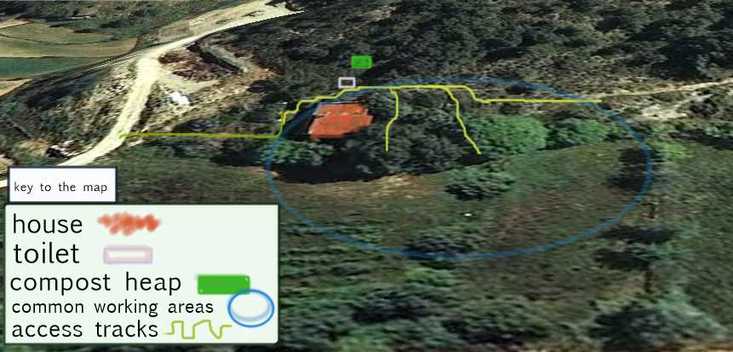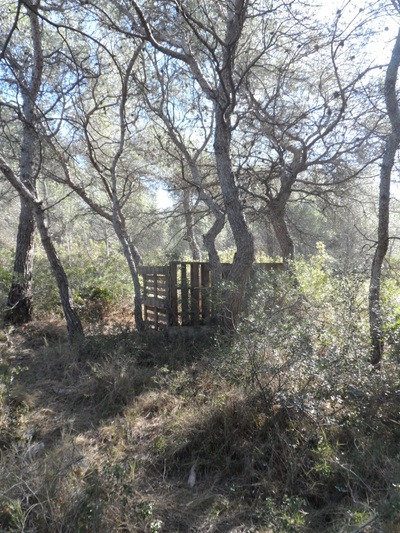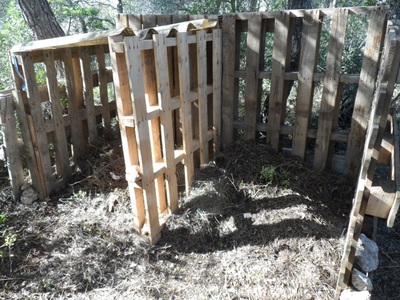Design
Design points to consider
- The toilet needs to be close to the house, whilst also easily accessed from the main working areas. The compost heap should be a manageable distance further to be able to carry the full buckets easily
- Waste must be in a sealed bucket to stop insects and flies entering, compost needs a constant supply of mulch to completely cover the waste
- Both structures to be sheltered from strong sun and rain (strong sun could overheat the compost too much, strong rain will leach the waste away from the compost heap) The toilet must be sheltered for the people inside to use comfortably whatever the weather
We decided to place the toilet at the back of the house where the pine forest begins. It's hoped that the trees will provide shelter from the heat and rain, whilst also giving some privacy. We thought we could also position the toilet so the trees can also provide some support for the structure.
This location is very close to the back of the house, with easy access on an established track from the front and back doors. There is also a track leading to the main working areas that can bypass the house. Being at the back of the house also allows some privacy.
The compost heap we placed further into the forest, away from the house. The area was overgrown but was easily cleared, and we made tracks made to the toilet. The forest floor is very deep with leaf litter, which is very good for collecting mulch, introducing beneficial insects to break down the compost. It is also on a slope so there will be no danger of flooding or water collecting around the compost pile.
In the beginning we used second hand paint buckets with the lids still intact, but the plastic degraded quickly and so we bought a cheap plastic bucket, which is working well.
This location is very close to the back of the house, with easy access on an established track from the front and back doors. There is also a track leading to the main working areas that can bypass the house. Being at the back of the house also allows some privacy.
The compost heap we placed further into the forest, away from the house. The area was overgrown but was easily cleared, and we made tracks made to the toilet. The forest floor is very deep with leaf litter, which is very good for collecting mulch, introducing beneficial insects to break down the compost. It is also on a slope so there will be no danger of flooding or water collecting around the compost pile.
In the beginning we used second hand paint buckets with the lids still intact, but the plastic degraded quickly and so we bought a cheap plastic bucket, which is working well.
And for the liquid gold?

I did think about making the toilet a double chamber; one side for collecting the solid waste, and one side for collecting urine. The urine could then be channelled from the bucket into a pipe that would then be mixed with water and then added onto the garden as an extra nitrogen fertiliser. I decided against this for several reasons: firstly we are still very low on water, so don't have a constant available supply to use on this, and for many garden plants pure urine can be too strong. Secondly the toilet is going to be located in the pine forest, where we don't currently grow a garden so we would need a long pipe, which we don't have. And thirdly, with visitors using the toilet we can't be sure that their urine doesn't contain chemical medicines and possible pathogens, most likely it sometimes will.
Keeping the urine mixed in with the rest of the humanure compost does help it to stay moist and also helps the composting process. When they are mixed together it can however make the bucket smell pretty strongly of ammonia, so we have chosen for now to keep a balance of urinating in the bucket sometimes (especially for girls and guests) and occasionally urinating directly around land (but not the food garden) at other times. The scent of urine on the land around the living areas keeps away wild pigs, which can come very close to the house and can be very dangerous, which I do worry about with a small child here. The small amount of urine being spread around such a large area of land is so minimal that we have never noticed it creating a smell.
Keeping the urine mixed in with the rest of the humanure compost does help it to stay moist and also helps the composting process. When they are mixed together it can however make the bucket smell pretty strongly of ammonia, so we have chosen for now to keep a balance of urinating in the bucket sometimes (especially for girls and guests) and occasionally urinating directly around land (but not the food garden) at other times. The scent of urine on the land around the living areas keeps away wild pigs, which can come very close to the house and can be very dangerous, which I do worry about with a small child here. The small amount of urine being spread around such a large area of land is so minimal that we have never noticed it creating a smell.
A map showing placement of the toilet and compost heap

Here you can see that the toilet is easily accessible from the working areas and the house, and being in the forest is hidden from view of the neighbours and visitors. The compost heap is not too far from the toilet, but is a good distance away from the house. The forest floor around the compost heap is also a good place to collect mulch to cover the waste.
Implementation
Here are some images of us building the toilet.
The compost heap
And here are some images of the compost heap, constructed out of pallets. So far we have only added two sections, one to store mulch collected from around the forest floor, and the other side for emptying the bucket. This side has a roof, so that heavy rain won't affect the composting process. As it fills up we will add a front to enclose the pile, and another side to create a second pile. We will also be adding a gutter and tank to collect rainwater to wash the buckets.
please continue to the next page here



